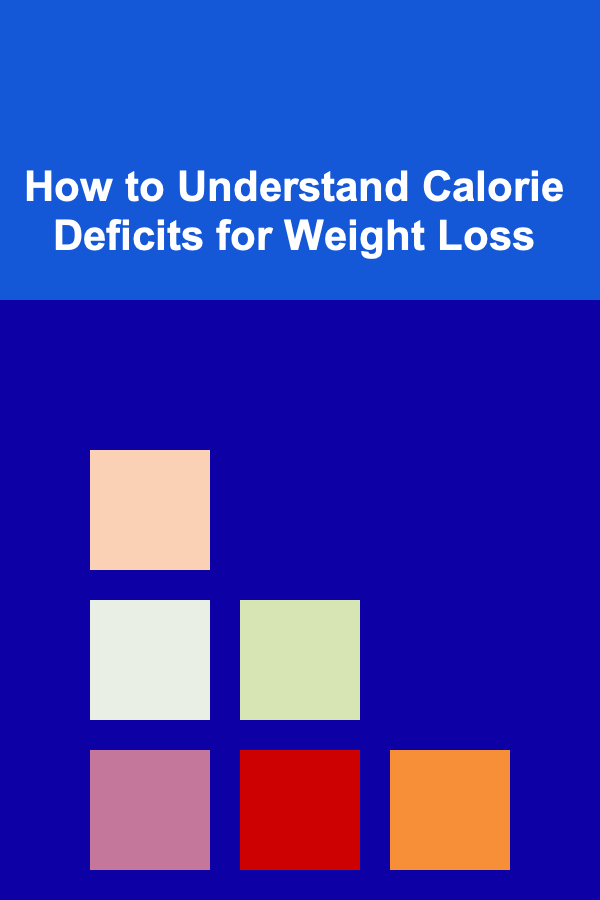
How to Design a Weekly Planner for ADHD Brains
ebook include PDF & Audio bundle (Micro Guide)
$12.99$8.99
Limited Time Offer! Order within the next:
Not available at this time

Attention Deficit Hyperactivity Disorder (ADHD) affects millions of people worldwide and can make managing time, staying organized, and keeping track of tasks a daily struggle. While traditional planners work for some, they might not be the best fit for someone with ADHD due to the nature of the condition. People with ADHD often find it challenging to prioritize tasks, stay on task, and remember deadlines, which makes creating an effective planner crucial.
In this article, we will explore how to design a weekly planner specifically tailored to the needs of ADHD brains. By understanding the specific challenges ADHD presents and using strategies that align with how ADHD minds work, we can create a system that encourages productivity, reduces overwhelm, and supports long-term success.
Understanding the ADHD Brain
Before diving into the design of a weekly planner for ADHD, it's important to understand how ADHD affects the brain and how this can influence time management and organization.
ADHD is a neurodevelopmental disorder characterized by:
- Inattention: Difficulty focusing on one task, easily distracted by external stimuli or internal thoughts.
- Impulsivity: Making decisions quickly without thinking about consequences.
- Hyperactivity: Feeling restless and unable to sit still.
These characteristics can make it difficult to stay on task, meet deadlines, or follow a standard weekly schedule. Therefore, the planner needs to accommodate these challenges in ways that maximize focus, promote consistency, and provide gentle reminders.
Why Traditional Planners May Not Work for ADHD
Traditional planners often rely on linear formats, rigid time blocks, and heavy text, which can overwhelm someone with ADHD. People with ADHD may find it difficult to:
- Stick to strict time-based schedules.
- Keep track of long lists of tasks without feeling overwhelmed.
- Maintain a structured daily routine.
This is why a planner for ADHD should be highly visual, flexible, and divided into smaller, manageable tasks. It should also provide space for frequent review, reminders, and the opportunity for creative expression.
Key Features to Include in a Weekly Planner for ADHD
Now that we understand the challenges, let's break down the key features that will make the weekly planner both ADHD-friendly and effective.
1. Clear and Simple Layout
An ADHD-friendly planner should have a clean, uncluttered design. Overcomplicated layouts can easily overwhelm individuals with ADHD, making it harder to use. The layout should focus on providing clear visuals, simple sections, and intuitive navigation.
- Big, bold fonts: Large, legible fonts help to catch attention.
- Visual cues: Use colors, icons, and shapes to make the planner visually appealing and easy to navigate.
- Whitespace: Ensure enough empty space between sections to reduce feelings of clutter.
2. Time Blocking (But with Flexibility)
People with ADHD often struggle with traditional time management techniques. However, time blocking can be incredibly effective for ADHD brains when done correctly.
The key here is flexibility. Instead of rigid time slots, offer blocks of time with open-ended sections, like:
- Morning Focus Block: Tasks to complete before lunch.
- Afternoon Focus Block: Tasks to complete after lunch.
- Evening Wind-down: Tasks for the end of the day.
By not assigning fixed times, you allow for movement based on how the day unfolds. This flexibility helps reduce stress and provides more space for creativity and focus when the mind is in a better state.
3. Daily Focus Areas or Themes
It's easy to get sidetracked when you have a long list of tasks. To combat this, break down each day into a specific focus area or theme. This could be:
- Monday -- Administrative Tasks: Bills, emails, and filing.
- Tuesday -- Creative Projects: Writing, designing, brainstorming.
- Wednesday -- Personal Development: Reading, meditation, exercising.
- Thursday -- Social Connections: Phone calls, networking, planning meetups.
- Friday -- Household/Errands: Laundry, groceries, cleaning.
By having a theme for each day, individuals with ADHD can stay focused on one area and prevent feeling overwhelmed by switching between completely unrelated tasks.
4. Visual Task Breakdown with Checklists
People with ADHD benefit from seeing tasks broken down into smaller, manageable steps. Large tasks can feel daunting and lead to procrastination, but breaking them into smaller tasks makes them feel achievable.
Instead of having one big "To-Do" list, break each task down by:
- Subtasks: Under each primary task, list out smaller, actionable steps.
- Checklists: Provide a space for checkboxes that allow individuals to track progress by checking off each step.
Checklists provide the satisfaction of completing tasks and help reinforce a sense of accomplishment. They also reduce the chance of forgetting important details.
5. Prioritization Tools
ADHD brains can easily get distracted by the least important tasks, leading to a lack of productivity. It's important to have a way of distinguishing between what needs immediate attention and what can wait.
To prioritize, you can use:
- The Eisenhower Matrix: Categorize tasks as urgent and important, urgent but not important, important but not urgent, and neither urgent nor important.
- Color-coding: Use different colors to mark tasks based on urgency or importance.
This system helps the ADHD brain focus on high-priority tasks first, preventing procrastination and the tendency to get sidetracked by non-essential activities.
6. Built-in Reminders
ADHD often comes with memory issues. People may forget tasks or deadlines, especially if they're not written down. Including reminder features in the planner can ensure that important tasks don't slip through the cracks.
- Reminders for upcoming deadlines: Set visual or written cues for tasks that need to be done by specific times, like an important phone call or a project submission.
- Daily reviews: Include a small section for reviewing the day's accomplishments and previewing the next day's tasks. This ensures continuity and reduces the chances of forgetting things.
A section like this helps reduce anxiety and makes sure nothing important is missed, even if someone is feeling distracted.
7. A Space for Reflection and Adjustments
ADHD brains are often in constant motion, which can make it hard to maintain consistency. Therefore, it's vital to have a reflective space in the weekly planner that encourages adjustments.
- Weekly reflections: Allow a space where users can jot down what worked well, what didn't, and how they felt throughout the week.
- Adjustments for next week: Based on these reflections, give room to modify next week's tasks or goals.
This encourages self-awareness and growth. It also creates an opportunity to reassess goals and strategies, helping individuals with ADHD stay flexible and resilient in their planning.
8. Accountability Sections
Staying accountable is one of the most important aspects of managing ADHD. A weekly planner should have built-in sections that encourage accountability, such as:
- Progress trackers: Track ongoing goals or habits throughout the week.
- Daily goals: Set small, achievable daily goals that are easy to track.
- Weekly check-ins: Designate a space for a weekly review, asking questions like: "What tasks did I accomplish? What could I improve for next week?"
These sections promote a sense of responsibility and provide feedback, which can be motivating for someone with ADHD.
9. Reward System
Positive reinforcement is an important motivator for ADHD brains. Add a reward system into your planner where small wins lead to larger rewards. For example:
- Stickers: Use fun stickers to mark completed tasks.
- Self-care rewards: After completing a task or meeting a goal, offer a small reward like watching a favorite show or treating yourself to something enjoyable.
By celebrating small successes, you increase motivation and encourage a sense of accomplishment, which is essential for sustaining long-term success.
10. Customization and Flexibility
Lastly, ADHD brains thrive in environments that are customizable and adaptable. Allowing for customization within the weekly planner helps users make adjustments based on their mood, energy levels, and evolving needs.
- Customizable sections: Offer blank spaces for users to create their own sections or make modifications based on personal preferences.
- Different templates: Provide different layout options to accommodate different workflows, whether they prefer detailed or minimalist designs.
Customizability ensures that the planner remains useful over time and doesn't become a source of frustration or rigidity.
Conclusion
Designing a weekly planner for ADHD brains requires thoughtful consideration of how ADHD affects daily functioning. By focusing on simplicity, flexibility, and visual appeal, and by incorporating strategies like time blocking, prioritization, and reflection, you can create a planner that helps manage time effectively and reduces overwhelm.
The goal of such a planner isn't just to stay organized---it's to create a system that works for you, acknowledging the challenges of ADHD while reinforcing strengths and successes. With the right tools and structure, individuals with ADHD can thrive in their daily lives and feel more in control of their time and tasks.

How to Create a DIY Organization Project for Kids
Read More
How to Design a Safe Outdoor Play Area for Kids
Read More
How to Explore Concentrated Solar Power with Thermal Storage
Read More
How to Understand Calorie Deficits for Weight Loss
Read More
Mastering the Reciprocating Saw: A Demolition and Tough Cuts Guide
Read More
How to Create a Worldbuilding Planner for Fantasy Writers
Read MoreOther Products

How to Create a DIY Organization Project for Kids
Read More
How to Design a Safe Outdoor Play Area for Kids
Read More
How to Explore Concentrated Solar Power with Thermal Storage
Read More
How to Understand Calorie Deficits for Weight Loss
Read More
Mastering the Reciprocating Saw: A Demolition and Tough Cuts Guide
Read More